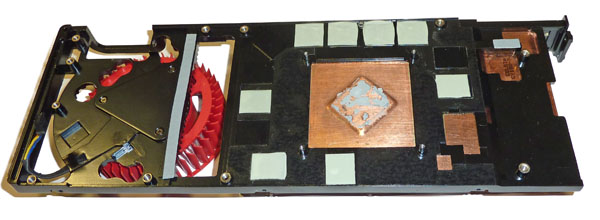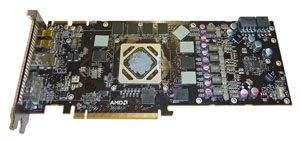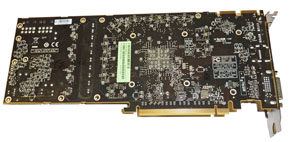The reference Radeon HD 7970
Bet you thought it was benchmark time on this page? Hold your horses, dear readers, as we take a look at the card itself.

Now encased in a slightly revised cooler that uses the same radial-fan technology as other high-end Radeon cards, the HD 7970 is exactly the same size as the HD 6970. This means it's 11in long and 1.5in high. The similarities continue with the weight, as both reference cards tip the scales at a smidge over 1kg.
Expect the first run of partner offerings to be stickered reference cards. Any initial differentiation will arrive in the form of the bundle. AMD informed us that partners are already green-lit to produce cards with custom coolers, though the positioning and presence of extra memory modules may require some cooler tweaking.
Feeling substantial and extremely well-built, AMD goes on to say that it's learnt a few lessons from constructing reference coolers for 200W-plus GPUs. You may have noticed a spate of non-reference cards situating all outputs on a single level on the IO section, mainly for better exhausting of airflow on the slot directly above. AMD follows the same tack here by dropping a DVI port. This leaves dual-link DVI, HDMI v1.4a and two mini-DisplayPort v1.2 outputs on the back.
Understanding that 3D is the rise, whether we want it or not, the HDMI specification supports 3D gaming at 120Hz, or 60Hz per eye, made possible through what is termed Fast HDMI (3GHz bandwidth, up from 2.25GHz, presumably), which also enables super-high 4K x 2K resolutions that are supported by a few projectors and mooted for next-gen displays. While we're on the topic of multimedia, AMD carries the same UVD 3 block over from the Cayman cards.
And it's also worth nothing that the multimedia improvements also include discrete digital multi-point audio. This is used in instances where a number of different displays are driven from the video outputs on the back. Each display's picture can now be piped with the correct audio, and the hardware on the HD 7970 is clever enough to move the audio should you decide to pull the video across to another screen.
Back on to the card, there remains the Cayman-introduced dual BIOS switch that can be used by partners for super-clocked models. And it won't surprise you at all to learn it's in the same position, next to the two CrossFireX connectors, as on Radeon HD 6970: why change a decent formula, right?

Rip off the plastic top cooler and the sixth-generation vapour-chamber design comes into view. Labouring a point, it looks similar to the Cayman's - a fact not altogether surprising given how alike in construction the reference designs are.

A plastic frame, incorporating the fan and chunky heatsink, surrounds the PCB. It's an all-in-one solution, as the memory chips are also cooled by the fan on the left-hand side. Let's bore you by saying it's very close in appearance to the HD 6970's.
Stripping it bare, 12 memory chips from Hynix surround the large die in the centre of the PCB. Each providing a 32-bit pathway and teaming up for the 384-bit interface on the card, more bandwidth is always good. We reckon that, should they so desire, add-in board partners could release a custom-designed PCB that's a little smaller than AMD's; there's plenty of space to be saved.
All said, the reference card holds no surprises for us. It's a well-engineered bit of kit that custom designs may struggle to beat.











